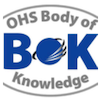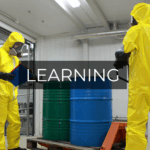Chapter 17.4: Process Hazards - Chemical
Abstract
Chemical process hazards may be associated with high-consequence outcomes of fire, explosion and/or release of toxic substances. While the management of such hazards is usually the responsibility of those with specialist process safety or chemical expertise, generalist occupational health and safety (OHS) professionals should understand the basic science underpinning the characteristics of such hazards, the mechanisms by which they cause harm, potential consequences – fire, explosion and toxic effect – and common controls. As a companion chapter to OHS Body of Knowledge 12.3 Managing Process Safety, and with reference to the Globally Harmonised System (GHS) of Classification of Labelling of Chemicals, this chapter provides information vital for understanding and applying process safety management strategies. Such knowledge will enable generalist OHS professionals to effectively engage with process safety and chemical safety experts, contribute to better hazard control and reduce the risk of catastrophic events.
Keywords: process safety, hazardous substances, chemical, fire, explosion, toxic release, GHS, barrier
First year of publication: 2017
Current Version: 2025
Chapter 17.4: Process Hazards - Chemical
Table of contents
| 1 | Introduction |
| 1.1 | Process for developing the chapter content |
| 2 | Historical perspective |
| 3 | Extent of the problem |
| 4 | Underpinning science |
| 5 | Chemical process hazards |
| 5.1 | Hazardous substances |
| 5.2 | Sources of ignition |
| 5.3 | Operating temperatures |
| 6 | Consequences |
| 6.1 | Fires |
| 6.2 | Explosions |
| 6.3 | Toxic effects |
| 7 | Legislation and standards |
| 8 | Control |
| 8.1 | Layers of protection |
| 8.2 | Barriers |
| 8.3 | Elimination |
| 8.4 | Prevention |
| 8.5 | Mitigation |
| 9 | Implications for OHS practice |
| 10 | Summary |
Useful resources
References

Trish Kerin BEng(Mech)(Hons), DipOHS, MLdrshp, GAICD, CEng, FIChemE
Professional Process Safety Engineer, FIEAust, Senior Member AIChE
Trish Kerin is an award-winning international expert and key note speaker on process safety leadership and was the inaugural director of the IChemE Safety Centre. She helps organisations share and learn in process safety. Trish leverages off her years of engineering and varied leadership experience to help organisations improve their process safety outcomes.
She has represented industry on many government committees and has sat on the board of the Australian National Offshore Petroleum Safety and Environmental Management Authority (NOPSEMA). She previously sat on the Mary Kay O’Connor Process Safety Center (MKOPSC) steering committee at Texas A&M University and is the Chair of the WorkSafe Victoria Major Hazards Advisory Committee.
She is a Chartered Engineer, registered Professional Process Safety Engineer, Fellow of IChemE and Engineers Australia and a Senior Member of AIChE. Trish holds a Diploma in OHS, a Master of Leadership and is a Graduate of the Australian Institute of Company Directors. Her expertise has recognised with the John A Brodie Medal (2015), the Trevor Kletz Merit Award (2018) and Women in Safety Network’s Inaugural Leader of the Year (2022). She has been named one of the “Superstars of STEM” for 2023/24 by Science and Technology Australia.
Learning Outcomes: Process hazards (Chemical)
The OHS Body of Knowledge takes a conceptual approach which enables it to be applied in different contexts and frameworks.
To optimise its value for education and professional development learning outcomes have been developed for each technical chapter in the Body of Knowledge.
The learning outcomes as described give an indication of what should be the capabilities of an OHS professional; it is up to those developing OHS education programs, OHS professionals planning their CPD or recruiters or employers selecting or developing people for the OHS function to consider the required breadth vs. depth .
Please read the section on using the learning outcomes before delving into the leaning outcomes of the individual chapters.
The numbers against each learning outcome refer to the chapter number of the BOK download page. No learning outcomes have been developed for the chapters considered introductory or underpinning knowledge (that is chapters 1, 2, 3, 4, 5, 6, 7, 1, .13, 14, 15.)
Extend Your Learning
Click on the images below for more information
Published 2019 Chapter 17.4 Process Hazards (Chemical)
Published 2017 Chapter 18.3 Process Hazards




